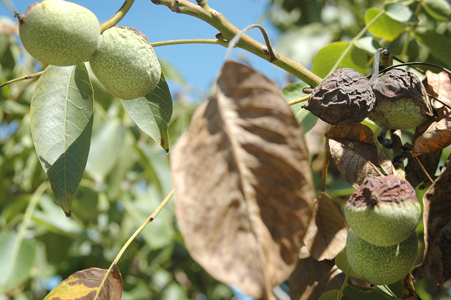
While harvest is still months off, major loss predicted
While agriculture remains the cornerstone of San Benito’s
economy, farmers were especially hard hit this summer with a warm
winter, heavy rains and a brief but strong heat wave that has those
still waiting to harvest in fear of what they will find.
While harvest is still months off, major loss predicted
While agriculture remains the cornerstone of San Benito’s economy, farmers were especially hard hit this summer with a warm winter, heavy rains and a brief but strong heat wave that has those still waiting to harvest in fear of what they will find.
Walnut growers may be especially disappointed when they start harvesting their nuts in October with agriculture experts and farmers alike predicting at least 30 percent of the crop to be lost.
“This is an extraordinary amount of damage to the walnuts,” said Paul Matulich, San Benito’s agricultural commissioner. “You may get 10 percent burn in a bad year, generally, but 30-50 percent is really terrible.”
Statewide walnut crops are likely to be affected by the hot temperatures this summer, according to Bill Coates, a farm adviser for San Benito County with the University of California Cooperative Extension. The quality of nuts that survived the sun damage may not be of high quality.
“Some [walnuts] that are not blackened at this point could have poor quality,” said Paul Hain, an organic walnut farmer.
Farmers such as Hain won’t know the full impact of this season’s weather until the walnuts are harvested, dried and cracked.
“But there is definitely at least 30 percent of no economic value at all,” he said.
The mid-summer heat wave came at the worse time for Payne walnuts, a variety that is popular in San Benito.
“Some of our orchards are very suscpetible. [Payne] was the old standard, but it is slowly being phased out because of problems like weather, disease and viruses,” Coates said. “Some later blooming varities are less susceptible to all of those problems.”
The walnut shells for Paynes were still soft and provided little protection from the heat, Matulich said. Hot days late in August, which are more usual in this region, have less of an effect on the walnut crops.
“It has to do with the shell,” Matulich said. “Once the shell gets hard, it protects them from the heat.”
“It’s going to reduce our tonnage and the price may be better because of the loss,” Matulich said of the cost of walnuts in the coming year. “But I wouldn’t want to be a walnut grower this year.
The lack of colder weather and the rains during the pollinating season led to a smaller than usual crop to begin with, but the week of hot summer weather really did in the walnuts, Hain said.
“The real kicker was this heat wave,” Hain said. “It burned back the shoots, leaves and nuts. I’ve never had such a severe sunburn problem.”
Most of the damage came in two days when temperatures in San Benito County reached 113 degrees. Hain missed an opportunity to shade his walnut trees on the first day temperatures soared because he was out of town at a farmers’ market.
“The damage was done by the time I got home,” he said.
The heat wave killed 100 of Hain’s meat chickens as well, livestock he raises organically to supplement his walnut income.
Walnuts are one of the top five fruit or nut crops grown in San Benito County, according to the 2005 annual crop report.
Nearly 2,000 acres of walnuts are grown in the county and nearly 1,300 tons were produced last year.
The 2005 season didn’t net as many tons as it could have, although the last harvest had less to do with the weather.
“The year was kind of unremarkable,” Hain said, who explained that walnuts alternate between a heavy crop and a lighter crop each year. “It just didn’t set very well, but the walnuts we did have were of a good quality.”
Despite a smaller than average crop in the county the gross income from walnuts in 2005 was $1.9 million, up $100,000 from 2004.
For farmers who rely solely on walnuts or use them as their largest income, the upcoming harvest is uncertain.
“We are putting many eggs in one basket and trying to do other things, but walnuts are the staple crop here so it’s going to hurt,” Hain said. “Would you like to lose a third of your salary for the year in two days?”









